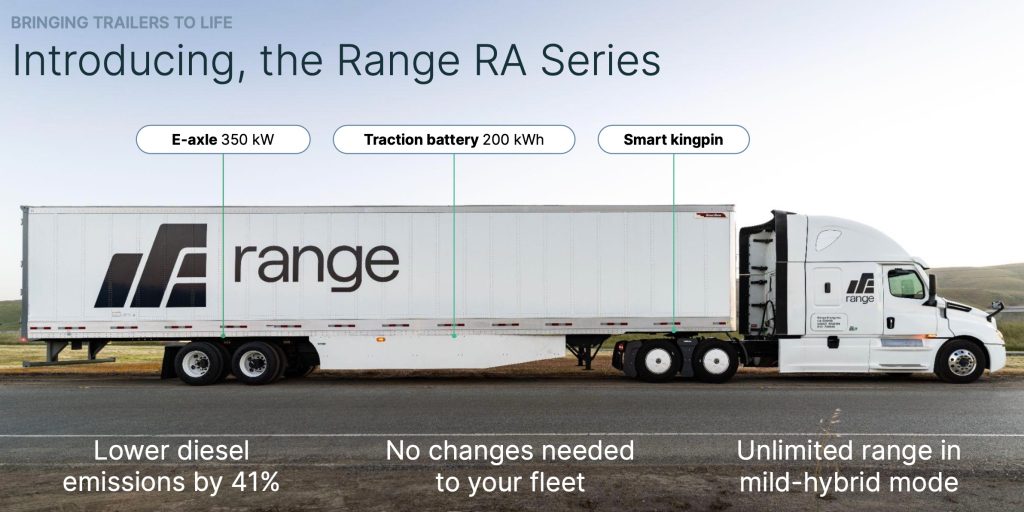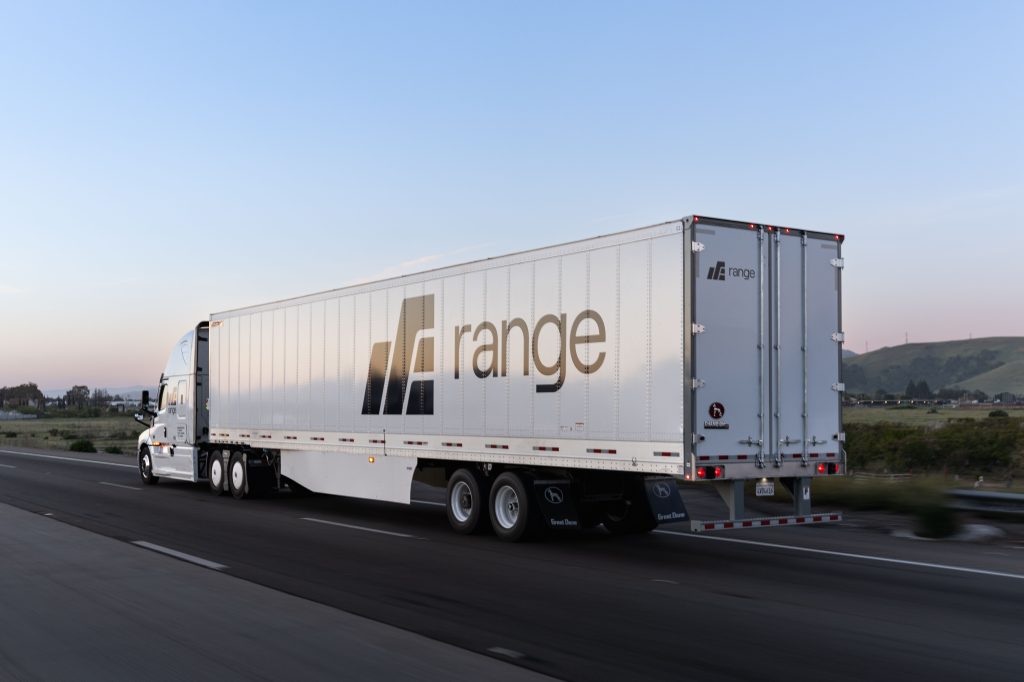
ACT Expo, the largest advanced fleet expo, is happening this week, and the question on everyone’s lips is: how can we electrify our fleet quickly?
Range Energy thinks it has the best answer, and it doesn’t require any retrofitting of tractors or engines, just a new trailer.
Range figured that so many people have thought about electrifying the semi-truck tractor, but nobody has really focused on the trailer. This makes sense considering the trailer is just dead weight on most trucks, so why would people think about changing the motive power of something without motive power?
But with EV tech, Range thinks it can change that and add more safety and fuel efficiency. And it can do this much more quickly than it takes to build and validate new electric trucks.
The idea is to add electric motors and a battery directly onto the trailer itself. This gives the trailer the ability to provide some of its own torque to help lighten the load on the diesel tractor, effectively reducing the amount of mass it needs to pull around on its own.

This just makes any load easier to carry. It should enhance the performance of the truck, making it easier to turn onto arterial roads, get up to speed on the highway, or perform passing maneuvers.
Range told us that when it drove down to ACT Expo, from Northern to Southern California, going over the famous Grapevine (Tejon Pass) was a cinch. The pass is famously difficult, featuring a 5-mile stretch of 6% grade, with shoulders dotted with frequent water stops for overheating engines. Range said it easily passed other trucks on the way up – and on the way down, it didn’t have to worry about brake fade since it used regenerative braking in the trailer to charge the battery.
And it doesn’t even take any additional communication between the tractor and the trailer. All of this is done through Range’s “smart kingpin.” This is just the standard interface on any truck trailer, but Range has put sensors in it to detect lateral loads from acceleration and braking. The sensors detect how much force the tractor is asking for, and Range spins up the motor in proportion.
Range showed us a demo of how this works on a shrunk-down prototype of its trailer, with a handle attached to a version of its smart kingpin:
Range says that its system can reduce diesel emissions by 41% and fits directly into a fleet without any changes to tractors or usage patterns. It can even be used in “mild-hybrid” mode if charging isn’t available, effectively turning a diesel truck into a hybrid without having to retrofit the engine itself.
Not every scenario will get that 41% reduction, but Range says even in the worst-case scenario, this impromptu hybrid system should improve efficiency by about 10%. (I question how this is possible at a steady speed on a flat road, but in normal operation that includes any amount of braking, the number seems reasonable.)
Of course, you’ll want to keep these batteries charged when possible because as long as you’ve got 200 kWh of batteries, you might as well use them. So you’d be wise to add charging to your yard, and the trailer accepts either 19 kW AC or DC up to 350 kW. Range hasn’t finalized a single charging solution yet, but spoke of the potential of adding various plugs, overhead charging systems, or even a contact interface at the rear of the trailer, which would automatically start charging whenever the trailer is in a loading bay.

This system enables zero-emission operation in many situations in which that might be desirable, like in yard operation, while idling, or in ports or other emissions-control areas. In these cases, the trailer could be used to push the tractor, and the tractor could be used just for steering. While this sounds unwieldy, Range reminded us that articulated buses often work in a “pusher” configuration, with the rear car of the bus providing motive power, so there shouldn’t be any difficulty there.
Adding batteries and motors to the trailer unlocks a lot of options and applications that a typical “dumb” trailer doesn’t have. It’s easier to add a powered liftgate or powered landing gear for one since you’ve already got power onboard.
Having energy onboard means being able to use the trailer for temporary installations that need power – think disaster response, where electric vehicles have proven capable. Or you could continue powering a refrigerated trailer even while the truck is parked – or when the tractor isn’t even connected.
And the trailer has bidirectional charging, so it could be used to power offboard equipment or to help balance the grid (and make money through energy arbitrage if your trailer spends a lot of time parked and plugged in).

Beyond these efficiency, utility, and performance gains, Range sees safety benefits with the system. By adding control to the rear axle, a truck can gain all sorts of modern safety features like stability control or jackknife protection. And the aforementioned regenerative braking protects against brake fade on long grades and makes obnoxious Jake brakes redundant – and those giant runaway truck ramps should see a lot less use.
It’s not all upsides, though – Range’s unit weighs about 4,000 lbs, which eats into your payload. Semi-trucks are limited to 80,000 lbs gross vehicle weight, and the more the truck and trailer themselves weigh, the less payload you can fit into them and stay under that 80k limit. Because electric trucks are heavier, they are given an additional 2,000 lbs of wiggle room, for a total of 82k lbs.
But Range’s system doesn’t qualify for that exception. It’s working on this issue with regulators, trying to get its unit qualified so that trucks with its trailer can access that additional 2k lbs, but it hasn’t received that allowance yet.
Range is moving quickly to try to get those allowances and also to get to market. Since almost all regulation is on the tractor and not the trailer (in fact, a said that the EPA and CARB can’t regulate trailers because they aren’t “self-propelled”), this means that Range can get its trailers to market much quicker than other manufacturers that are still going through regulatory processes to bring truck tractors to market. And then Range can get those trailers onto trucks more quickly since further modification of the tractor isn’t needed.
And as a startup staffed by many people who have worked in fast-moving EV startups before (the CEO, Ali Javidian, worked at Tesla from 2008-2012), Range is moving quickly. It plans to have trailers for sale next year, though we’ll have to see how that works out, especially when it comes to battery supply, which has been difficult lately.

Range argues that its solution is necessary and helpful because we need action now on climate change, and these trailers can be deployed more quickly and with less capital than converting a whole fleet.
That said, California’s huge new truck rule has some pretty aggressive timelines, including an end to new diesel purchases for drayage trucks at the end of this year. So Range may find its market disappearing over time as everyone converts to fully electric operation.
The company still thinks that it will have a niche since its trailers could even give electric trucks the additional safety benefits mentioned above or could be used as range boosters for EV trucks as well. If, say, someone needs a 400-mile truck but can only find a 300-mile truck that fits their other specifications, adding a Range trailer could give them the boost they need.
It’s still early days for Range, and though it is moving quickly, there’s a lot of distance from here to there. We don’t know pricing or availability yet, though Range says it’ll be in the market next year. And while the company is promising a lot, most of these promises seem fairly realistic, and nobody else is doing anything like this (that we know of). We’re certainly excited to see more from Range as it moves forward.
Author: Jameson Dow
Source: Electrek



